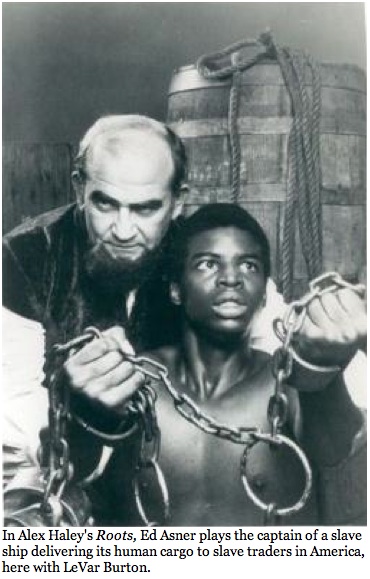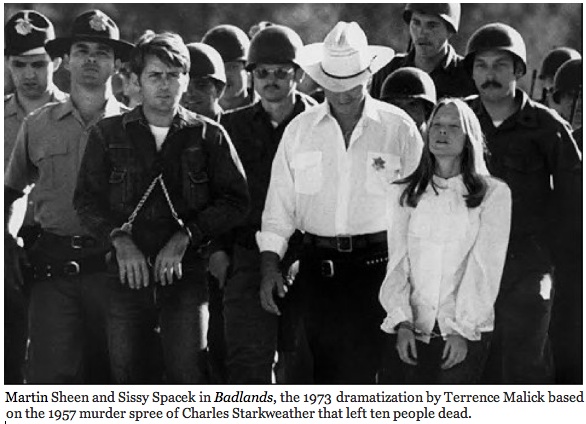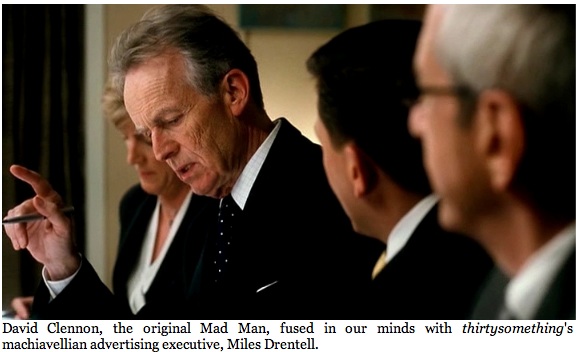
We expect actors as talented and esteemed as Martin Sheen, Ed Asner, and David Clennon to know all about the principles of irony, catharsis and sublimation at play in theatrical dramatizations. Simply stated, these are methods of portraying human events and behaviors that are detrimental to real people and societies, but which -- besides providing fuel for artistic and entertaining dramatizations -- are crucial to our understanding that simulation of inhuman behavior can be for a higher end. An end such as informing audiences of the hidden and heinous activities we want to eliminate from our lives and our governments -- not least of which are those activities of which many in the audience may be unaware.

Sheen, Asner and Clennon have joined the protest against Zero Dark Thirty (ZDT) for its depiction of torture conducted at Abu Ghraib in 2003, asking members of the Academy of Arts and Sciences for a search of conscience before voting for the film as an Oscar honoree. The scene rightly requiring conscientiousness depicts an al-Qaeda detainee named Ammar, who we learn is a (fictional) nephew of Khalid Sheik Mohammad, the mastermind of the 9/11 attacks. His torture leads to nothing but purposely inane answers -- shouting out all 7 days of the week -- when he is asked to supply a day and location for an expected attack on Saudi soil. To paraphrase one commentator, Ammar is but one more of the tortured detainees who but spews so much that there is no way to tell truth from lie. The victim simply provides whatever he can to try to make the torture stop. As a result of the torture's failure to procure information from Ammar, the intelligence community is prevented from intercepting the deadly bombing.
ZDT shows that torture alone did not work and that scores of Saudis were killed because of such failure. But the unwillingness of the anti-ZDT camp to acknowledge this fact helps to enable the Right Wing to falsely claim ZDT as their own xenophobic propaganda, when the film depicts the emptiness of such exploitive pseudo-patriotism. If director Kathryn Bigelow and screenwriter Mark Boal were apologists for torture, their fiction would have the detainee Ammar give up the name while being waterboarded, or while humiliated by the other sadistic acts inflicted on him. The filmmakers also undercut the competency and authority of the CIA throughout the film in a manner that compelled acting-CIA director Michael Morrell to criticize the film for its portrayal of the Intelligence community. What more do we need to hear and see to understand that there is a clear divide between the way the CIA sees itself and the way that Bigelow and Boal view the CIA?
Part of the problem here is that the anti-ZDT camp indicates in their statements that they have little awareness of the principles of irony, catharsis, and sublimation that dramatizations use to separate depiction of heinous activities from endorsement of them. They also show themselves to be unaware that throughout her films, Bigelow supplies a strain of anti-authoritarianism that is sometimes overt, and sometimes subtle. Bigelow has expressed as much when she disclosed, in an interview with the New York Times' Manohla Dargis, her aim as a filmmaker is to depict how "fascism is very insidious, we reproduce it all the time." Bigelow's insight courses through ZDT as we witness efforts on all sides to impose controls beyond those sanctioned by democratic principles and humane values.
But then many people who value film primarily as entertainment understandably don't have the time or interest to acquaint themselves with artistic principles, even though they practice them unconsciously. It's why, when events such as murder, rape, war, and torture are played out before our eyes onscreen, we generally assume that such depictions aren't endorsements for the real thing. For instance, The Museum of Broadcast Communications recounts that for the first episode of the televised version of Alex Haley's Roots, "the writers created a conscience-stricken slave captain, Thomas Davies," played by Ed Asner, "a figure who did not appear in Haley's novel but was intended to make white audiences feel better about their historical role in the slave trade." Conscience-stricken or not, Asner's slave captain is depicted delivering his human cargo to the slave dealers in colonial America. And no one picketed Roots come awards season for endorsing slavery for obvious reasons, even though by Asner's reasoning they should have.
More pertinently, when Martin Sheen played the psychopathic killer Kit, in Terrence Malick's Badlands, the divide between fiction and reality remains ever present despite that we know that Sheen's dramatized crimes are based on the 1957 murder spree of Charles Starkweather that left ten people dead in the mid-western U.S. Perhaps because David Clennon's role as the Machiavellian advertising executive, Miles Drentell, in the television drama, thirtysomething, was sustained for several years, the blurring of the actor with the real machinations so many viewers have suffered under bosses is the hardest illusion of the three to shake. Yet no one literally confounds this role with their performer.

Perhaps audiences do require being alerted to when an artistically-minded director such as Bigelow is largely abstaining from the use of standard cinematic techniques to manipulate us emotionally. Ordinarily we encounter such heavy-handed directorial controls as shooting a character from a low camera angle to unconsciously trigger recollection of our childhood experience of looking up to authority figures. Music is similarly scored to manipulate us emotionally, as when dark chromatic chords are orchestrated to reinforce our apprehension of an ominous setting or a loathsome character, while a lush string section heightens a romantic interlude, or a tempo accelerates for a scene of imminent crisis.
All of these devices are ironic in that they help to make presumably morally conscientious actors appear as rapists and terrorists. In reality the devices -- compelling acting, camera angles, and musical instrumentation -- are simply abstract effects producing varying modulations of pleasure or displeasure within its audience. They are also conventions that Bigelow uses sparingly so to underline the starkly existential conditions unfolding. The result is that those viewers who are hooked on conventional Hollywood manipulations are disoriented by Bigelow's abjuration of them. It's an understandable confusion. But it is a confusion on the viewer's part.
Catharsis and sublimation are deeply complex and largely unconscious functions that often work together as we experience art and entertainment. In essence, catharsis is achieved when we become so enrapt in a dramatization that we live vicariously through it. It is most valuable when scenes in a production enable us to work through our own personal traumas and grief by emotionally fusing them with similar events onscreen -- say the death of sympathetic characters. But catharsis is theoretically also thought to help us to individually fortify our own social sublimation -- to repress our antisocial, even criminal, yet natural tendencies, while elevating our higher consciousness through a continual exposure to depictions of socially lauded acts.
While irony tells us it's okay to enjoy watching a serial killer onscreen because we know it's not really a serial killing we are watching, catharsis works to satisfy, and thereby dispel, whatever primal desires that lead to criminal behavior reside within us without our knowledge. At the same time, sublimation enables us to convert whatever negative desires we possess into socially acceptable efforts -- which includes making art about murdering, raping and stealing, and awarding artists with Oscars for making such art. Whatever we think of art and entertainment depicting immoral behavior -- and those thoughts run the full gamut -- we have to agree that the representation of human maladjustments are more preferable than the deeper, darker urges that underpin them. And, yes, this may mean that we who enjoy watching murders onscreen do so because we still, despite all our civilizing influences over the course of millions of years of evolution, still contain some remote aspect of the defensive/offensive character traits of our animal ancestors that result in wanton violence.
This becomes exceedingly important when we realize that our media-saturated populations learn more about the world today from watching images in the media, than we do from observing life experiences -- especially when young. This is especially true of an event such as ideologically- or institutionally-induced torture, which few people in democracies have experienced. Hence, short of experiencing it, we can only learn what something as covertly practiced as waterboarding is by visual example. Since most people don't watch or read serious documentaries, their only visual experience of torture is procured by watching dramatizations, just as earlier generations only learned from drawings and paintings -- such as Goya's master series of etchings, The Disasters of War.
Research conducted within mass culture over the past fifty years shows that advertising and mass media have increasingly become the primary sources for the presentation and apprehension of world views superseding even those constructed by religion and science. If the findings of market and media researchers can be relied on, mass media, and its marketing in particular, are found to operate as cultural documents -- ways of presenting, apprehending, and construing the world in much the same way as religion, science, common sense, art, or political ideology formerly represented knowledge and knowing. The repetitive ritualization of advertising and media lead cultural perceptions to become represented and psychologically embraced as natural representations of the world or at least an esteemed if not definitive reality. If people are apathetic to torture, it is because they have never witnessed or experienced it in life -- but also because they haven't witnessed its effects in the kind of art that heightens its horrific nature.

There is no doubt in my mind that Martin Sheen, Ed Asner, and David Clennon, all actors whom I admire for their craftsmanship, and with whom I share so many left-liberal values -- are eminently aware of irony, catharsis and sublimation. Which is why I cannot understand why these three men abandon these principles in their judgment of what can be counted among the most politically and artistically justifiable depictions of torture in recent film. Surely they recognize their own employment of these methods in the criminally heinous roles they have played. No one believes for a minute that Martin Sheen -- who is more likely the ideal U.S. president in the minds of liberals than any man who filled the Oval Office -- could possibly gun down innocent bystanders. And who in their right mind could picture Ed Asner delivering a cargo of African captives to slave traders in colonial America?
The saddest effect of the anti-ZDT camp is its swerve toward a new McCarthyism. I admit that it's not the most adept analogy, but it's altogether too disproportionate to make comparisons between the anti-ZDT camp and the denunciations of artists by the early Leninists, Stalinists, and Maoists that escalated into the exiling, imprisonment, and execution of artists. But we should remember that it was such slides of the left into wholesale fascism that set even the most benign factions of the left back politically in America and Europe for over half a century. Which is why I ask Sheen, Asner, Clennon and their supporters to consider how they are helping to fracture the left with their censoring of art from the awards it deserves. The advocates of artist's rights to free and fair expression -- especially those attuned to such widespread principles as irony, catharsis, and sublimation, and so adeptly applied by Kathryn Bigelow in ZDT -- aren't likely to follow you into summoning to mind the blacklisting of the 1950s.
And if they do, I promise that many will regret it when the same denunciations are turned on the productions they make and star in. Please, remember the heinous crimes that you participated in making seem real, but were as far from being real as your formidable talents made them seem. To continue in this effort to blacklist Zero Dark Thirty is an affront to artists and their Constitutional right to free speech.
______
To read public statements made by the Bush and Obama administrations, CIA and Congressional officials between 2008-2011 that inform the film, see G. Roger Denson's post, "Zero Dark Thirty Account of Torture Verified by Media Record of Legislators and CIA Officials."
To read more by G. Roger Denson about Zero Dark Thirty and the social and political responsibility of artists, see his post, Zero Dark Thirty: Why the Film's Makers Should Be Defended and What Deeper bin Laden Controversy Has Been Stirred.
Read other posts by G. Roger Denson on Huffington Post in the archive.
